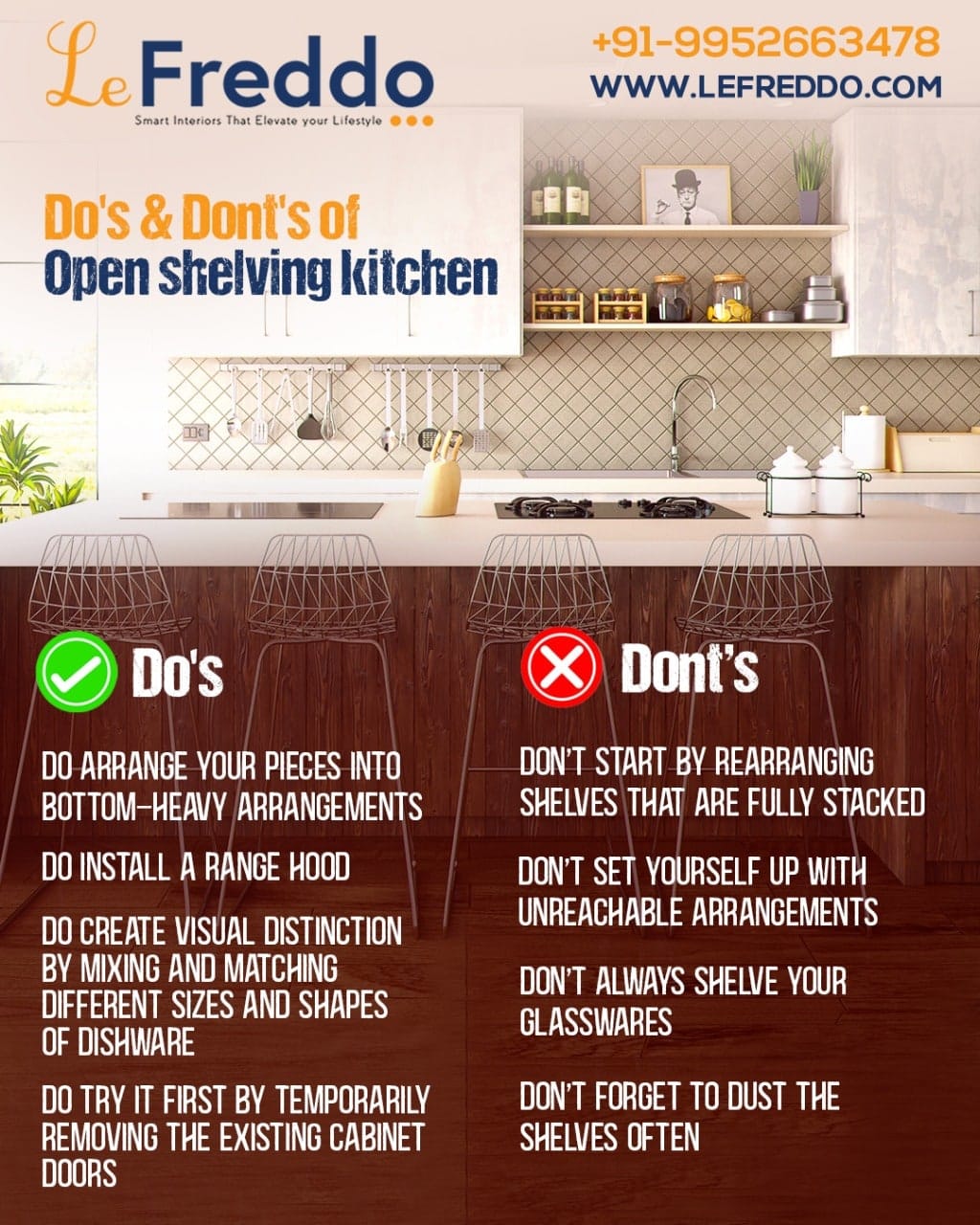
Do’s and don’ts of open-shelving Modular kitchen
Wall-mounted cabinets above your counters would have been a foregone conclusion if you were redesigning your kitchen just a few years ago. Open shelves, on the other hand, have become something of a decorator’s standard. Perhaps it’s the current trend of de-cluttering. Removing upper cabinets and replacing them with shelves is one of the simplest and most cost-effective methods to modernize your kitchen.
In the kitchen, open shelving offers a unique opportunity to display your dishware (and your personality). You might think the storage and organization choices it provides are as limitless as the shelves themselves, but making the incorrect decision here could transform your sunny design vision into an unsightly, cluttered disaster. Consider these suggestions from LeFreddo designer of the best modular kitchen in Salem to upkeep, and style before going with open shelving to get the most of this trendy trend in kitchen design.
Dos
Do arrange your pieces into bottom-heavy arrangement
We all have heavy objects in our kitchens, such as heavy casseroles, dinner sets, or large storage items like grains that we only use once a month. It’s not a good idea to keep heavy objects on the upper shelf because accidents can happen. Lifting and lowering large goods from these locations can be inconvenient, dangerous, and time-consuming. Furthermore, these shelves may not be able to support a lot of weight.
Do install a range hood
Consider the last time you opened a cupboard and found the door or knob to be sticky. Grease, cooking odors, and stove condensation are frequently found on kitchen surfaces. Open shelves can leave their contents subject to obstinate and filthy accumulation without the protection of a wooden or glass door. Consider adding a range hood to remove undesirable heat, smoke, scents, and grease particles from the air before they land on your belongings.
Do create visual distinction by mixing and matching different shape and sizes of dishware
Larger, more sculptural items (such as pitchers or ornate bowls) should be spaced out between stacks of plates or groups of canisters if possible. The more large and tiny items you balance against one other across your shelves, the more meaningful they will feel.
Do try it first by temporarily removing the existing cabinet doors
Before committing to an open shelf layout, give it a try by removing existing cabinet doors temporarily. This is a fantastic, low-cost update that gives you a preview of how your new shelves will appear. If you don’t like the look—or discover that you can’t keep your shelves organized enough for the new style—you can easily revert by replacing the hinges on the doors.
DON’TS
Don’t start by rearranging shelves that are fully stacked
Don’t begin by simply rearranging products on shelves or styling shelves that are already filled. Remove all of your belongings off the shelves to clear out your workspace. You’ll be able to apply a fresh, well-planned organizational strategy and tweak the aesthetics of your shelf arrangement once you have a clean slate.
Don’t set yourself up with unreachable arrangements
All of your cookware will appear more accessible now that the barriers produced by your cabinet doors have been gone. Allowing this seeming convenience to encourage you to store must-have basics like as frequently used dishes, everyday Corningware, and your spice collection on higher shelves is a mistake. Rather, keep basic necessities within easy reach and save the higher shelves for ornamental items and rarely-used dishes.
Don’t always shelve your glassware
Avoid placing glassware on floating shelves, especially if you reside in an earthquake-prone area. This is especially true at the top levels, where these items are more likely to shatter. Instead, consider storing them in any remaining closed cabinet spaces or on a wheeled bar cart. Install shelves with a lip at the edge to avoid any moving objects from sliding and falling out, making your storage even more disaster-proof.
Don’t forget to dust the shelf often
When you have open shelves in your home, you’ll need to increase your dusting routine. After all, you’re going for a stylish minimalist look, right? You could end up with fuzzy bud vases and books, or platters and plates, if you neglect your dusting tasks. Every two weeks or so, wipe clean your shelved things. To keep shelves appearing elegant, clear them out and give them a good dusting once a month.
Special shelves are also required for kitchen objects such as plates, bowls, and teapots. Because of their weight and material, it’s important to construct a solid storage system for them. In example, if your glassware breaks into pieces due to a faulty storage system, it will be a waste. You might try to replicate designs made of durable materials such as wood, pipe shelves, and screws. You’ll have enough room to stack things this way. Likewise, make sure it’s big enough to fit a microwave and other higher goods in. On the other hand, it is durable and won’t set you back a lot of money. You may repurpose old wooden doors or cupboards for your open shelving kitchen concept by cutting and repurposing them.
Open shelving, when used and maintained properly, can make rooms appear larger and offer a sophisticated touch to your home. These do’s and don’ts on open-shelving will help you clear and rearrange, whether you already have open shelves or are considering installing them.
